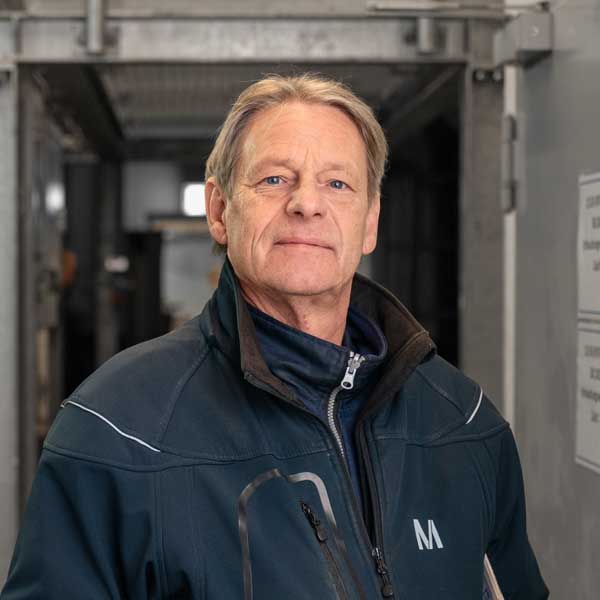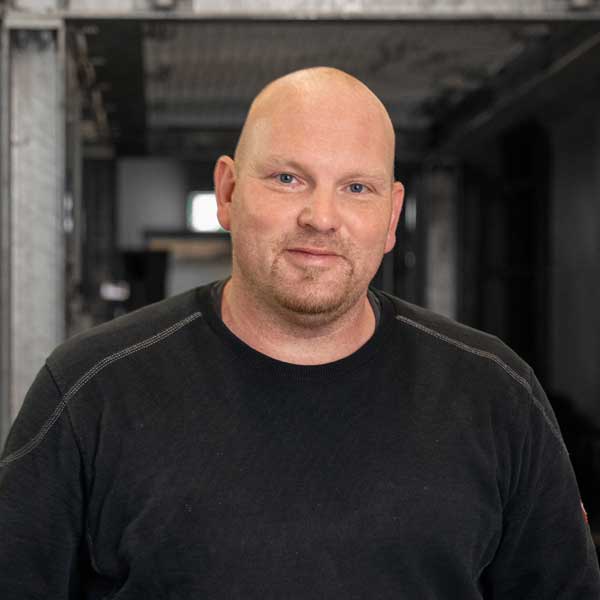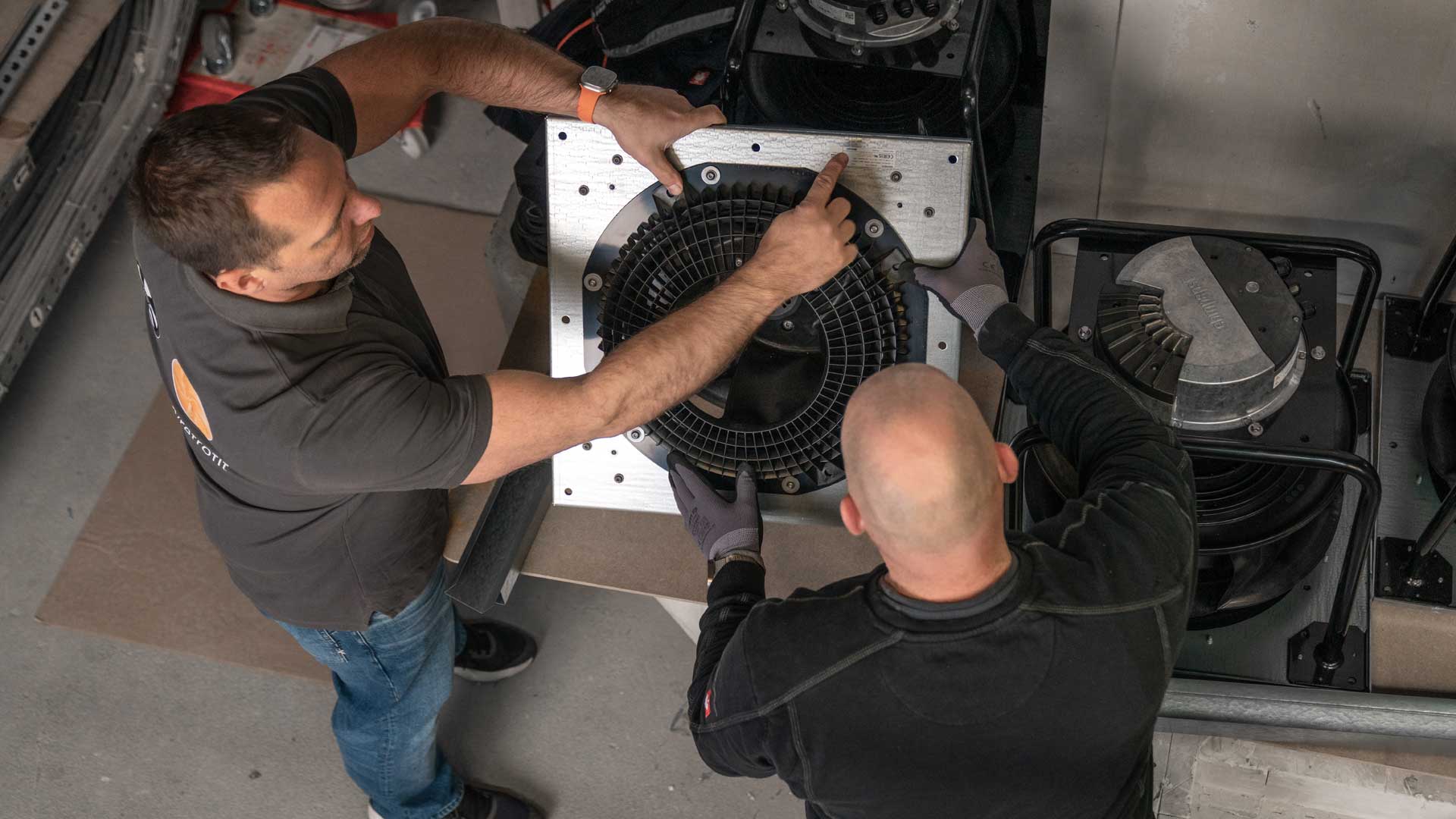With around 41.6 million passengers in 2024, Munich Airport is one of the busiest in Europe. High-performance infrastructure is absolutely essential here. This incluedes the two North and South connecting tunnels: the north tunnel connects the 5-star Hilton Hotel, Hall F and the P22, P1 and P5 multi-storey parking lots with the terminal area. The south tunnel provides a direct underground connection between the P20, P5 and P8 parking garages and the terminal area.
“When one of our fans failed in the fall of 2024, we had to act quickly,” recalls Thomas Rühmann, Project Manager for Energy Management at Munich Airport. The systems in question were as old as the airport itself; they worked with one large belt-driven fan for the supply and exhaust air per tunnel. This outdated technology had considerable disadvantages: in addition to the high energy consumption, the lack of operational safety was a major issue. For this reason, simply repairing the old solution was not an option – only a comprehensive retrofit. “We normally have three to four months for such projects,” explains Rühmann. “But here we had to find a solution within a month.”
The retrofitters

Thomas Rühmann
… is Project Manager for Energy Management at Airport Munich GmbH. He comissioned the retrofit for more efficiency and operational reliability.
Stephan Jendrallek
… ist Managing Director at Lüftungsmontagen Jendrallek and, together with his team, took over the dismantling of the old systems and the installation of the new solution.


Dieter Hildebrandt
… is retrofit specialist at the ebm-papst service center Breuell & Hilgenfeldt. He suggested the new fan solution, delivered the RadiPac and took care of calibrating and setting up the control system.
Fresh air for tunnels
Since 1992, the north and south connecting tunnels have been ventilated by one supply and one exhaust air system each. This means a total of 4 belt-driven fans that are more than 30 years old. And also at different levels with a height difference of 2.4 meters.
Get rid of the dirt
The old solution is also problematic from a hygiene point of view due to its various wearing parts. The abrasion of the belts, for example, causes contamination in the air ducts, or bearing grease can be distributed on the fan, V-belt and housing. The impurities not only lead to contamination of the air that the system distributes, but also facilitate the spread of fire in the event of a fire.
Quite a lot to lift
Stephan Jendrallek and his team work with heavy tools. The old engines weigh up to 400 kilograms, so cranes are used. This is the only way to maneuver the aging parts through the narrow aisles of the tunnels.
“We had to act quickly”
The retrofit takes place under time pressure at the beginning of December 2024 – Stephan Jendrallek and his team cut the old fans into individual parts within a few days and remove them from the system along with the motors. This is followed by preparations for installing the new solution. Stephan Jendrallek has already produced special pressure bulkheads for this, into which the new fans will be mounted as a FanGrid.
Installation is child’s play
To keep the installation phase as short as possible, Dieter Hildebrandt suggested plug-&-play RadiPac C fans. These make handling and installation child’s play, for example thanks to the support plates. Jendrallek’s team installed a total of 34 RadiPac C fans in specially manufactured pressure bulkheads. Each 8 to 9 RadiPacs form a FanGrid.
Everything integrated
The RadiPac C comes with a FlowGrid air inlet grill, integrated MODBUS interface and automatic resonance detection. The latter was particularly important to the airport team for the operational safety of the systems.
What can automatic resonance detection in ventilation systems do?
If a fan is frequently operated at excessive vibration levels – caused by dirt deposits, for example – this can have a negative impact on its service life. The RadiPac C therefore features automatic resonance detection. For this purpose, a test start-up is carried out during commissioning, which analyzes the vibration velocity over the entire speed progression from standstill to the nominal speed. When the fan is installed in the system, integrated vibration sensors detect the resonances and the software avoids operation in the critical ranges detected.
The user can edit the software settings manually at any time, so they always have full control. If the vibration speed increases during operation, for example due to dirt deposits on the impeller and the resulting additional imbalance, the software issues an automatic warning. The user has the option of checking the system for additional imbalances and taking measures to rectify the fault (e.g. cleaning and/or new run-up).
Operational safety ensured
The supply and exhaust air systems each have a FanGrid. The advantage of this fan wall is its redundancy: if one of the fans fails, the others automatically take over the missing power. The 61,000 m3/h or 68,000 m3/h volume flow required by the airport is thus guaranteed.
Integration via MDC
The MODBUS interface is already integrated in the high-performance electronics of the RadiPac C. This enables simple integration into the airport’s building management system via MDC (Modbus Display and Control).
Parameters in real time
The MDC can record various parameters in real time. For example, the speed of the individual fans or the operating hours of the system, which greatly simplifies automated monitoring and control.
up to 68%
efficiency at
nominal volume flow
30%
energy savings
in both systems
252,000kWh
savings in total
252,000 kilowatt hours saved per year
The retrofit pays off in several ways: “We will save around 252,000 kilowatt hours per year in future,” says Rühmann happily. The project will therefore pay for itself within a few years. The contribution to climate protection is just as important – Munich Airport wants to achieve the goal of net zero emissions by 2035, and every kilowatt hour saved will help.

Leave a comment